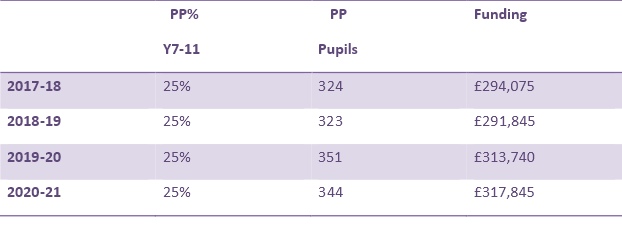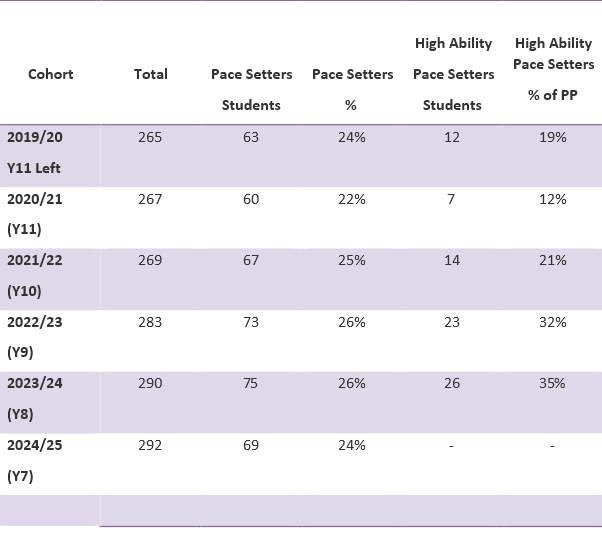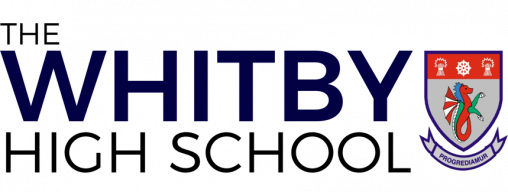
- Home
- /
- COVID Support Spending
COVID Support Spending
Pupil premium pace setters 2020-21
This strategy is designed to enhance the progress made in narrowing the gap, by year group, for socially disadvantaged students.
The Pupil Premium was introduced in April 2012. It was allocated to children from low-income families who were known to be eligible for free school meals, and children who had been looked after continuously for more than six months. Eligibility for the Pupil Premium for 2012 – 2013 was extended to students who have been eligible for free school meals at any point in the last 6 years (known as Ever 6 Free School Meals Measure). Schools also receive funding for children who have been looked after continuously for more than six months, and a smaller amount for the children of service personnel.
Schools employ strategies, validated by research, that support students to improve their attainment, and ‘narrow the gap’. Schools are accountable for narrowing the gap, and school performance tables include measures that show the attainment of students who receive the pupil premium compared with their peers. The Pupil Premium Grant (PPG) provides funding for two polices:
- Raising the attainment of disadvantaged students of all abilities to reach their potential
- Supporting children and young people with parents in the regular armed forces
https://www.gov.uk/government/publications/pupil-premium/pupil-premium
Pupil premium funding
In the 2020 to 2021 financial year, schools will receive the following funding for each child registered as eligible for free school meals at any point in the last 6 years:
- £955 for secondary-aged pupils
- £310 per Ever 5 Service Children pupils and
Schools also receive £2,345 Pupil Premium+ for each pupil who:
- has been looked after for 1 day or more
- has been adopted from care
- has left care under:
- a) A special guardianship order
- b) A residence order
- c) A child arrangement order

At The Whitby High School, we have used research from various sources, including the Education Endowment Fund’s (EEF) Teaching & Learning toolkit, the Pupil Premium Awards and the DfE’s families of schools database to help us plan how to use our additional funding.
Research carried out by Sutton Trust (July 2016) to identify which ways of spending time and money are likely to lead to the biggest possible increase in pupils’ learning indicates:
www.educationendowmentfoundation.org.uk
- One to one – potential gains of 5 months
- ICT – potential gains of 4 months
- Homework (Secondary) – potential gains of 5 months
- Phonics – potential gains of 4 months
- Collaborative Learning – potential gains of 5 month
- Smaller group sizes – Potential gains of 5 months
- Feedback – Potential gains of 8 months
- Meta cognition – Potential gains of 8 months
- Holiday courses – Potential gains of 2 months
- Mastery Learning – Potential gains of 5 months
- Reading Strategies – Potential gains of 5 months
- Peer Tutoring – Potential gains of 6 months
John Dunford's 'Ten Point Plan'
This helps to inform our practice and identify key areas of spending.
‘High quality teaching must be at the core of all pupil premium work. It follows that it is legitimate to spend PP funding on raising the quality of teaching.’
Step 1: Articulate a whole school goal which will be achieved through PP funding.
Step 2: Analyse the specific barriers to learning for PP students at The Whitby High School.
Barriers to learning might include poor parenting, limited access to language, poor literacy levels, poor attendance, low aspirations, low expectations, narrow experience of life outside school.
Step 3: Define the desired outcomes of PP spending.
Step 4: Against each desired outcome, identify success criteria.
Step 5: Evaluate current PP strategies.
Step 6: Research the evidence of what works best – three recommendations:
a) Seek out excellent practice in other schools, using National College and Pupil Premium Awards
b) Use the excellent Education Endowment Foundation Toolkit,
c) Study the Ofsted report on pupil premium where there is a list of successful approaches on page 3 . Evaluate PP strategies in the light of the points made in this report.
Step 7: Decide on the optimum range of strategies to be adopted.
Step 8: In-
Step 9: Monitor the progress of PP-
Step 10: Put an audit trail on the school website for PP spending.
PIXL’s ‘Closing the Gap Toolkit’ will be utilized to inform best practice from the latest research and development in this area. When Brian Lightman from PIXL considers why the gap matters, it is ‘because people matter and it remains our moral imperative to improve the life chances of all young people and especially the most vulnerable.’
The Whitby High School context

Spending, impact & evaluation
Please view the documents below for further information on how we have used our Pupil Premium allocations to ensure that it has a direct impact on the students that require it most.
